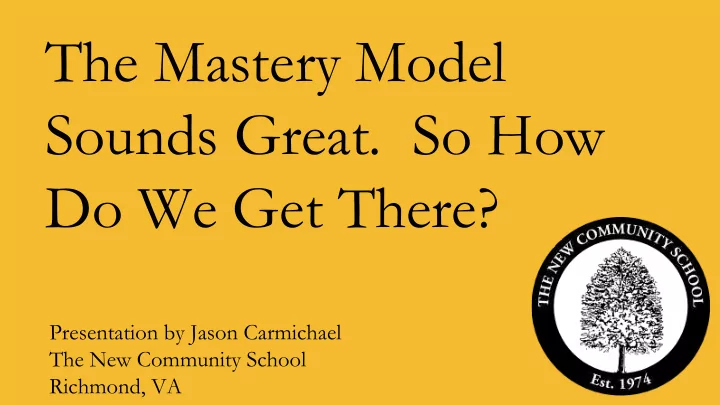

The Mastery Model Sounds Great. So How Do We Get There? Presentation by Jason Carmichael The New Community School Richmond, VA
Objectives 1. Explore the promise of mastery model and how it can redefine teaching and learning in the 21st century. 2. Explore the ideas behind standards-based grading and grading reform, including how they differ from the traditional model. 3. Create an action plan with achievable next steps.
The promise of the mastery model How would your instruction be different if you didn’t have to worry about grades? What could you do that you currently are not able to do?
What are our obstacles?
Sounds nice, but… Here There
Grading Activity Turn to page 2 of your handout and grade the assessment. How you choose to grade it is up to you.
Traditional vs. Standards-Based Traditional Model Standards-Based Model • 5 levels of success • 100 point scale • More assessment, less • Grade everything that grading moves. • Grading based on • Rewards/punishments proficiency towards the • Average together all learning objectives evidence of learning. • Failure to “get it” early on does not impact grade
Issue 1: The 100-point scale
The problem with the 100 point scale Starch and Elliott Research Findings • 2 papers given to 147 English teachers ✦ Paper 1: 64-98 (34 point variance) ✦ Paper 2: 50-97 (47 point variance) ✦ 15% gave one paper a failing grade, while 12% gave it over a 90. • Geometry assessment given to 128 Math teachers ✦ Scores ranged from 28-95 (67 point variance) (Starch and Elliott, 1912 and 1913 )
How SBG addresses this problem • 5 levels that are meaningful and understandable • 80% of the levels are passing • Easier jump from one level to the next • Greater consistency/reliability in grading
Issue 2: Grade EVERYTHING
The problem with grading everything “If you don’t grade it, the students won’t do it.” • Feedback is lost • Learning stops • Encourages a fixed mindset
How SBG addresses this problem • Less grading, more assessment • Focus on practice and growth rather than task completion • Opportunities to reassess and demonstrate increased understanding
Issue 3: Using grades as rewards/punish ments
The problem with using grades as rewards/punishments • Late penalties/grade caps • The outlier of 0 G1 G2 G3 G4 G5 G6 Average G7 Average 100 98 96 98 96 100 98 0 84 51 56 63 65 68 70 62 0 53 • Reward grades • Extra credit
How SBG addresses this problem • The “real world” argument (“I’ll get fired if I’m late”) - let’s be realistic • Separates skills (or lack thereof) from the grade • Eliminates the outlier 0 • Moves behavioral attributes to a different reporting mechanism (because they are most definitely important!)
Issue 4: Averaging old evidence and new evidence
The Problem with Averaging Old and New Grade 1 Grade 2 Grade 3 Grade 4 Grade 5 Average Billy 80 80 80 80 80 80 Johnny 100 90 80 70 60 80 Susie 60 70 80 90 100 80 Ellie 50 50 100 100 100 80 Tommy 88 88 88 88 50 80
How SBG addresses this problem • The focus is put on where the student is at NOW, not where the student used to be • Comparison to “real world” - driving test
The TNCS Journey to SBG • Year 1- Faculty-led study group • Year 2- Expanded study group, identified key leaders • Year 3- Full faculty summer reading; department leadership attended conferences • Year 4- Additional summer reading; curriculum design workshops; expert facilitated PD • Year 5- Expanded piloting • Year 6- School-wide implementation of SBG
Action Plan Take the next 5 minutes to brainstorm an action plan on page 6 of your handout. • Where are you now? • Why is grading reform important to you? • What are your next steps? • Who/what are your obstacles? • Who/what are your allies?
Questions/Feedback Jason Carmichael jcarmichael@tncs.org Please rate this session in the NAIS Events Mobile App: • Go to the workshop listing • Click on the Clipboard icon to the left of the event description to provide valuable feedback on the workshop that you just attended.
Recommend
More recommend